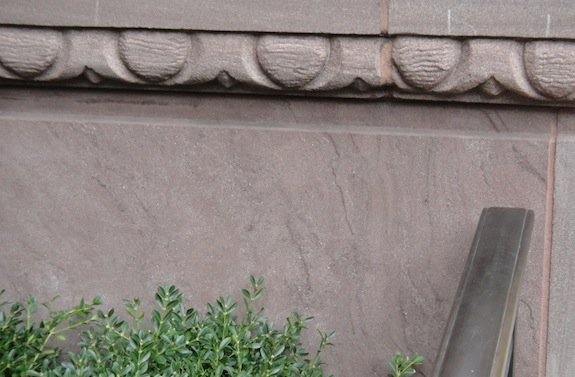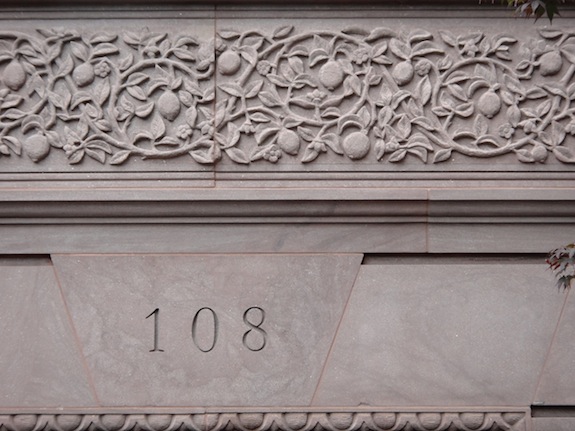Back in the late 1800s when most of Harlem was built brownstone was all the rage. It was a local stone (quarried in Connecticut) and less expensive than limestone. BUT brownstone is a far softer and more porous stone than limestone. The limestone façades aged much better than the brownstone ones did.
 One problem was that brownstone has a distinct grain where limestone doesn’t. People in the 1880s and 1890s didn’t really like to see the grain so the stone was cut in line with the grain. That meant that as water got into the stone and froze the stone would sheer along the lines of the grain and flake off. You can see this happening on our house in the picture to the right.
One problem was that brownstone has a distinct grain where limestone doesn’t. People in the 1880s and 1890s didn’t really like to see the grain so the stone was cut in line with the grain. That meant that as water got into the stone and froze the stone would sheer along the lines of the grain and flake off. You can see this happening on our house in the picture to the right.
To compensate people have been painting brownstone, and putting stucco finishes over it that simulate brownstone. You don’t actually see many true brownstone finishes in Harlem any more. That’s always made me wonder what brownstone was supposed to look like…
This past weekend we went to Pasvalco over in New Jersey and I mentioned to the woman who was helping us that we were renovating a brownstone but I wasn’t sure what brownstone was supposed to look like. She showed us pictures of a project they did on the Upper West Side for Mark Gorton – founder of Limewire (software that facilitates illegal fire sharing). Back in 2005 he bought 108 West 76th Street for $4.8M (all cash) and then proceeded to do a major renovation on the place. He (almost) completely replaced the brownstone façade on his 5 story, 9,250 sq. ft. single family townhouse. Pasvalco did the job using brownstone quarried from Connecticut. So if you take a look at 108 W 76 that is how brownstone is supposed to look…
In the picture below you can see how much grain there is in brownstone…
 That’s with brownstone cut “correctly” – with the grain showing so it won’t flake. As I mentioned, back in the 1800s they cut it differently so the grain wouldn’t show so much, but that caused flaking. I personally think the grain is rather beautiful…
That’s with brownstone cut “correctly” – with the grain showing so it won’t flake. As I mentioned, back in the 1800s they cut it differently so the grain wouldn’t show so much, but that caused flaking. I personally think the grain is rather beautiful…
 Given that brownstone used to be less expensive than limestone but now it’s far more expensive, I asked one of the guys why that was. The answer was pretty simple – there used to be 30 or 40 brownstone quarries in Connecticut, now there is just one quarry and it’s only a 3 man operation. Simply put the owners of the other quarries made more money turning their land into condo developments (land in Connecticut is expensive). In contrast there are still lots of large limestone quarries in places like Indiana and shipping costs are (relatively) lower than they were in the late 1800s.
Given that brownstone used to be less expensive than limestone but now it’s far more expensive, I asked one of the guys why that was. The answer was pretty simple – there used to be 30 or 40 brownstone quarries in Connecticut, now there is just one quarry and it’s only a 3 man operation. Simply put the owners of the other quarries made more money turning their land into condo developments (land in Connecticut is expensive). In contrast there are still lots of large limestone quarries in places like Indiana and shipping costs are (relatively) lower than they were in the late 1800s.
 One other factor that makes brownstone expensive is that the stone yards have to assume 100% waste when working with brownstone. So they have to quarry twice the amount they need. With limestone there’s much less waste, so less material is needed to complete the job.
One other factor that makes brownstone expensive is that the stone yards have to assume 100% waste when working with brownstone. So they have to quarry twice the amount they need. With limestone there’s much less waste, so less material is needed to complete the job.
While raw, properly cut brownstone is gorgeous, it’s simply cost prohibitive for Harlem brownstones. In our case our façade is currently painted and in generally decent condition. For the most part only the lintels and sills are deteriorating – most of everything else is in pretty good shape. The National Park Service allows you to repaint in a situation like ours, so that’s what we’ll be doing. We’ll repair what damage we find and then repaint. The next most expensive solution would be to chip and resurface with a brownstone-like stucco – but we need to control costs…

Nice review, Jay. The other (probably primary) reason the brownstones were clad in edge bed (vs. the proper natural bed) brownstone, was that edge bed stone is much cheaper to quarry.